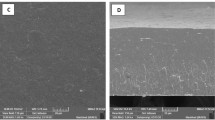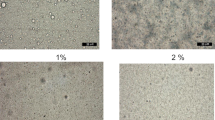Abstract
Capsaicin has many benefits, such as pain relief, cancer prevention, and weight reduction. However, the application of capsaicin has been limited in the food industry due to its strong pungency, odor, and low solubility in water. Therefore, a multilayer nanoemulsion with chitosan and hyaluronic acid was developed for masking its odor and taste and improving the physicochemical stability against the surrounding environment. The capsaicin-fortified yogurts were prepared by blending various concentration levels of multilayer nanoemulsion (0–15%, w/v). The quality of yogurt was determined as a function of pH, acidity, viscosity, and total lactic acid bacteria population in an extended storage period (21 days). The multivariate statistical analysis was used to compare the quality of yogurts supplemented with capsaicin nanoemulsion. As a result, this study demonstrated the potential of capsaicin-loaded multilayer emulsion-supplemented yogurt as a novel nutrition-fortified food.




Similar content being viewed by others
References
Akbas E, Soyler B, Oztop MH. Capsaicin emulsions: Formulation and characterization. Journal of Dispersion Science and Technology. 38: 1079-1086 (2016)
Alfaro L, Hayes D, Boeneke C, Xu Z, Bankston D, Bechtel PJ, Sathivel S. Physical properties of a frozen yogurt fortified with a nano-emulsion containing purple rice bran oil. LWT-Food Science and Technology. 62(2): 1184-1191 (2015)
Anthero AGS, Moya AMTM, Torsoni AS, Cazarin CB, Hubinger MD. Characterization of Capsicum oleoresin microparticles and in vivo evaluation of short-term capsaicin intake. Food Chemistry: X. 13: 100179 (2022)
Askin B, Öztürk D, Durusoy B, Kaya Y. Properties of yogurt fortified with capsaicin extracts dissolved in high oleic sunflower oil. Journal of Food Processing and Preservation. e15633 (2021)
Badran MM, Taha EI, Tayel MM, Al-Suwayeh SA. Ultra-fine self nanoemulsifying drug delivery system for transdermal delivery of meloxicam: dependency on the type of surfactants. Journal of Molecular Liquids. 190: 16-22 (2014)
Beal C, Skokanova J, Latrille E, Martin N, Corrieu G. Combined effects of culture conditions and storage time on acidification and viscosity of stirred yogurt. Journal of Dairy Science. 82: 673-681 (1999)
Chang SH, Lin HTV, Wu GJ, Tsai GJ. pH Effects on solubility, zeta potential, and correlation between antibacterial activity and molecular weight of chitosan. Carbohydrate Polymers. 134: 74-81 (2015)
Choi AJ, Kim CJ, Cho YJ, Hwang JK, Kim CT. Characterization of capsaicin-loaded nanoemulsions stabilized with alginate and chitosan by self-assembly. Food and Bioprocess Technology. 4(6): 1119-1126 (2011)
Codex Alimentarius Commission. Codex standard for fermented milks. Codex Stan 243–2003 (2015)
Damin MR, Minowa E, Alcantara MR, Oliveira MN. Effect of cold storage on culture viability and some rheological properties of fermented milk prepared with yogurt and probiotic bacteria. Journal of Texture Studies. 39: 40-55 (2008)
Erasmus SW, Muller M, Butler M, Hoffman LC. The truth is in the isotopes: Authenticating regionally unique South African lamb. Food Chemistry. 239: 926–934 (2018)
Fardous J, Omoso Y, Joshi A, Yoshida K, Patwary MKA, Ono F, Ijima H. Development and characterization of gel-in-water nanoemulsion as a novel drug delivery system. Materials Science and Engineering: C. 124: 112076 (2021)
Garavand F, Rouhi M, Razavi SH, Cacciotti I, Mohammadi R. Improving the integrity of natural biopolymer films used in food packaging by crosslinking approach: A review. International Journal of Biological Macromolecules. 104: 687-707 (2017)
Granato D, Santos JS, Escher GB, Ferreira BL, Maggio RM. Use of principal component analysis (PCA) and hierarchical cluster analysis (HCA) for multivariate association between bioactive compounds and functional properties in foods: A critical perspective. Trends in Food Science & Technology. 72: 83-90 (2018)
Gumus CE, Gharibzahedi SMT. Yogurts supplemented with lipid emulsions rich in omega-3 fatty acids: New insights into the fortification, microencapsulation, quality properties, and health-promoting effects. Trends in Food Science & Technology. 110: 267-279 (2021)
Guner A, Ardıc M, Keles A, Dogruer Y. Production of yogurt ice cream at different acidity. International Journal of Food Science & Technology. 42: 948-952 (2007)
Hong IK, Kim SI, Lee SB. Effects of HLB value on oil-in-water emulsions: Droplet size, rheological behavior, zeta-potential, and creaming index. Journal of Industrial and Engineering Chemistry. 67: 123-131 (2018)
Isleten M, Karagul-Yuceer YONCA. Effects of dried dairy ingredients on physical and sensory properties of nonfat yogurt. Journal of Dairy Science. 89: 2865-2872 (2006)
Jandrić Z, Cannavan A. An investigative study on differentiation of citrus fruit/fruit juices by UPLC-QToF MS and chemometrics. Food Control. 72: 173-180 (2017)
Kim JH, Ko JA, Kim JT, Cha DS, Cho JH, Park HJ, Shin GH. Preparation of a capsaicin-loaded nanoemulsion for improving skin penetration. Journal of Agricultural and Food Chemistry. 62: 725-732 (2014)
Kim SH, Lim CH, Lee C, An G. Optimization of growth and storage conditions for lactic acid bacteria in yogurt and frozen yogurt. Journal of the Korean Society for Applied Biological Chemistry. 52: 76-79 (2009)
Kong M, Park HJ. Stability investigation of hyaluronic acid based nanoemulsion and its potential as transdermal carrier. Carbohydrate Polymers. 83: 1303-1310 (2011)
Li R, Lan Y, Chen C, Cao Y, Huang Q, Ho CT, Lu M. Anti-obesity effects of capsaicin and the underlying mechanisms: a review. Food & Function. 11: 7356-7370 (2020)
Luesakul U, Puthong S, Sansanaphongpricha K, Muangsin N. Quaternized chitosan-coated nanoemulsions: A novel platform for improving the stability, anti-inflammatory, anti-cancer and transdermal properties of Plai extract. Carbohydrate Polymers. 230: 115625 (2020)
Lund JA, Brown PN, Shipley PR. Differentiation of Crataegus spp. guided by nuclear magnetic resonance spectrometry with chemometric analyses. Phytochemistry. 141: 11-19 (2017)
Machado TADG, de Oliveira MEG, Campos MIF, de Assis POA., de Souza EL, Madruga MS, Pacheco MTB, Pintado MME, do Egypto RDCR. Impact of honey on quality characteristics of goat yogurt containing probiotic Lactobacillus acidophilus. LWT-Food Science and Technology. 80: 221-229 (2017)
Mahmoodi Pour H, Marhamatizadeh MH, Fattahi H. Encapsulation of different types of probiotic bacteria within conventional/multilayer emulsion and its effect on the properties of probiotic yogurt. Journal of Food Quality. 2022: 1-12 (2022)
Pathakoti K, Manubolu M, Hwang HM. Nanostructures: Current uses and future applications in food science. Journal of Food and Drug Analysis. 25: 245-253 (2017)
Qin H, Huo D, Zhang L, Yang L, Zhang S, Yang M, Shen C, Hou C. Colorimetric artificial nose for identification of Chinese liquor with different geographic origins. Food Research International. 45: 45-51 (2012)
Silva HD, Poejo J, Pinheiro AC, Donsì F, Serra AT, Duarte CM, Ferrari G, Cerqueira MA, Vicente AA. Evaluating the behaviour of curcumin nanoemulsions and multilayer nanoemulsions during dynamic in vitro digestion. Journal of Functional Foods. 48: 605-613 (2018)
Sun J, Perry SL, Schiffman JD. Electrospinning nanofibers from chitosan/hyaluronic acid complex coacervates. Biomacromolecules. 20: 4191-4198 (2019)
Tamjidi F, Nasirpour A, Shahedi M. Physicochemical and sensory properties of yogurt enriched with microencapsulated fish oil. Food Science and Technology International. 18: 381-390 (2012)
Vignesh S, Sivashanmugam A, Annapoorna M, Janarthanan R, Subramania I, Jayakumar R. Injectable deferoxamine nanoparticles loaded chitosan-hyaluronic acid coacervate hydrogel for therapeutic angiogenesis. Colloids and Surfaces B: Biointerfaces. 161: 129-138 (2018)
Yang E, Fan L, Jiang Y, Doucette C, Fillmore S. Antimicrobial activity of bacteriocin-producing lactic acid bacteria isolated from cheeses and yogurts. Amb Express. 2(1): 1-12 (2012)
Acknowledgements
This research was supported by Basic Science Research Program through the National Research Foundation of Korea (NRF) funded by the Ministry of Education (grant of NRF-2016R1D1A1B03933896) and by Institute of Biomedical Science & Food Safety, Korea University, Republic of Korea.
Author information
Authors and Affiliations
Contributions
JAK—Conceptualization, methodology, validation, formal analysis, investigation, resources, data curation, JK—Conceptualization, methodology, validation, formal analysis, investigation, resources, HD—Data curation, writing—Original Draft, writing—Review & Editing, HJP—Supervision, project administration, funding acquisition.
Corresponding authors
Ethics declarations
Conflict of interest
This paper has no conflicts of interest and the results reported in this manuscript have not been published elsewhere nor have they been submitted for publication elsewhere.
Additional information
Publisher's Note
Springer Nature remains neutral with regard to jurisdictional claims in published maps and institutional affiliations.
Rights and permissions
Springer Nature or its licensor (e.g. a society or other partner) holds exclusive rights to this article under a publishing agreement with the author(s) or other rightsholder(s); author self-archiving of the accepted manuscript version of this article is solely governed by the terms of such publishing agreement and applicable law.
About this article
Cite this article
Ko, J.A., Kim, J., Doh, H. et al. Quality evaluation and storage test for capsaicin-fortified yogurt based on the multilayer nanoemulsion system. Food Sci Biotechnol 33, 441–451 (2024). https://doi.org/10.1007/s10068-023-01386-y
Received:
Revised:
Accepted:
Published:
Issue Date:
DOI: https://doi.org/10.1007/s10068-023-01386-y




